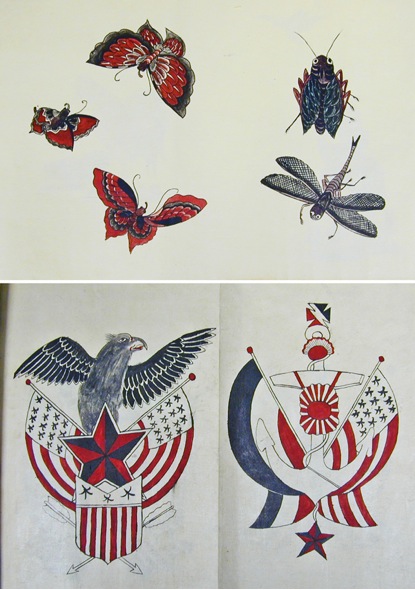Japanese tattoo designs
Kobe, Japan, early 20th century
 Donated by William Gowland in 1906; 1906.18.8
Donated by William Gowland in 1906; 1906.18.8
Here are two pages from a series of twenty-six sheets of illustrated tattoo designs, bound together to form a book. It was collected in the city of Kobe in southern Japan in the first years of the 20th century.
The woodblock prints of 19th-century Japan depicted beautiful women, naturalistic scenes of landscapes, trees and flowers, but mostly rebel hero characters (suikoden) from popular stories and kabuki plays, whose bodies were adorned with dragons, tigers, mythical beasts, deities and other religious images. This led to a demand for such folkloric tattoos among the urban working classes: labourers, factory workers, firemen, and prostitutes, as well as merchants and other more bourgeois followers of fashion. In many cases it was the woodblock printers themselves who also tattooed human skin, often using the same tools: chisels, gouges, and the famous Nara black ink which turns blue-green under the skin.
In the mid-19th century, after centuries of isolation, Japan opened up to the rest of the world. In 1868 the Shogunate system of the Edo period ended and the Meiji Restoration witnessed the return of imperial power to a new and forward-looking Japan. In order to create a good impression on the West, the Emperor banned tattooing in case it was thought barbaric. However the ban did not extend to foreigners so many traders, tourists and sailors who visited Japanese shores could get tattooed legally. The future King George V famously got a tattoo of a red and blue dragon on his arm during a stop at Yokohama in 1882 when he was a midshipman aboard HMS Bacchante.
This book, dating to the turn of the 20th century, perfectly illustrates this phase of Japanese tattoo culture as it is designed to appeal to Western tastes. The top sheet is from the first half of the book, which consists of traditional animal and naturalistic motifs such as birds, beasts, insects and flowers. The bottom sheet is from the second half of the book that contains naval and military 'badge' motifs, often with American flags and eagles to attract US sailors.
East Asian tattoos still heavily influence the Western tattooing industry today, designs that incorporate butterflies, oriental flowers, and the characters (kanji and hanzi) used in Oriental scripts proving enduringly popular.
